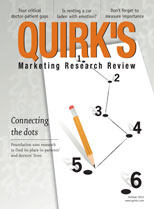Editor's note: Dan Prince is president of Catalyst Healthcare Research, Nashville, Tenn. For more information contact robyn.burns@catalysthcr.com. This article appeared in the October 8, 2012, edition of Quirk's e-newsletter.
While many medical practices are struggling to meet basic patient expectations, some are doing very well and want to go further in providing an exemplary patient experience. Knowing this, Catalyst Healthcare Research tested 10 above-and-beyond patient service ideas in an online survey of 400 Baby Boomers. Innovators in health care who implement one or more of these ideas stand to build stronger patient loyalty and differentiated brands.
Baby Boomers agree that if doctors' offices could begin performing certain behaviors and stop performing others, the patient experience would improve. Let's take a look at 10 ways doctors' offices can enhance the patient experience.
The dos
Eighty-eight percent agreed that handing a patient a printed summary of their visit as they leave the office, including the diagnosis and recommended plan of action, would make the patient experience better.
Eighty-six percent said doctors should talk to a patient about changing their behavior, rather than immediately prescribing a drug for their situation.
Eighty-two percent said the doctor should provide a patient with a reliable estimate of their charges for a specific surgical procedure that they need.
Sixty-six percent would like the doctor's office to offer an app that allows a patient to log in securely to see test results, send private messages to the doctor, etc.
Sixty-four percent would like the doctor's office to send a text message about 30 minutes before a scheduled appointment to tell them if the doctor is running on schedule.
Sixty percent agreed that doctors should use a mobile device (smartphone or tablet) to look up information about a drug before telling a patient about it.
Thirty-five percent would like the doctor's office to offer free Wi-Fi so that a patient can connect to the Internet while they are waiting to see the doctor.
The don'ts
Eighty-four percent of respondents agree that a doctor spending most of his/her time typing on a computer, not making eye contact with the patient, makes the patient experience worse.
Sixty-seven percent dislike when doctors' offices schedule patients to see a doctor but then have a nurse practitioner visit with them.
Fifty-nine percent agree that doctors' offices should avoid confronting or encouraging a patient to change their personal behaviors that are affecting their health (like smoking or obesity).
